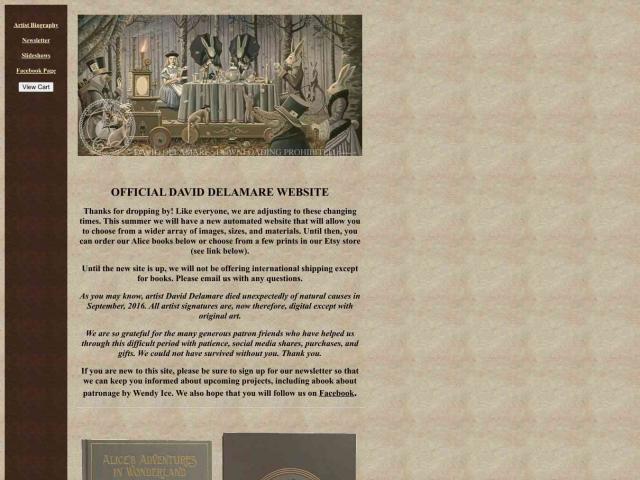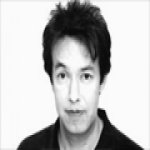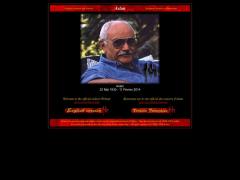David Delamare
David Delamare
Information
Very Organic Creative Process
David knew from a very early age that he was an artist, and has always earned his living through art. In his early years he set up a business painting signs and he occasionally taught art, but he is proud of the fact that he never had a "real" job.
Where does David get his ideas?
This is always a difficult question to answer. The best ideas always spring from sources unknown. But certainly ones milieu and interests play a part. David is an avid film and theater goer. He also loves Shakespeare and attends the festivals.
He listens to music while he paints (from Mozart to Gershwin to Randy Newman) and he is an avid reader (favorite authors include Samuel Beckett, John Cheever, Edith Wharton, and Alan Bennett.) These influences often find their way into his paintings. Typically, he hears a phrase in a play or a passage of music and feels compelled to translate the idea into a visual form. But, his creative process is very organic and often his finished paintings are quite different from his original conceptions.
Why does he use so many "animal" characters in his picture books?
David paints anthropomorphized animals to suggest human characteristics. An animal can be a great form of shorthand for personality types. When we say that someone moves like a cat or acts like a weasel, others understand us perfectly. While his picture books are enjoyed by children, they are actually written for adults. David believes that the best children's stories are meaningful at any age, and numbers among his personal favorites Alice In Wonderland, Peter Pan and Wind In The Willows.
WORKING METHODS:
How long does it take David to complete a painting?
This continues to be the most common question David is asked at signings. But the answer depends upon when one decides a painting begins. Is it when the idea begins to take shape or when the brush first meets the canvas? Some ideas arrive suddenly while others percolate for weeks, months, or even years. When they finally arrive fully formed, the actual painting is achieved remarkably quickly. While a typical painting might be completed in a week, some of his finest work has been completed in less than a day.
What mediums does he use?
In his early years, David painted in gouache (an opaque water-based medium) but he discovered that acrylics offered more luminosity, resulting in higher quality reproductions. Today he also works with oil paints which provide more texture and depth than acrylics. Oils also slow him down, keeping him more aware of the painting process. Most often he uses both, using acrylic for underpainting and oil for detailing, and he sometimes adds other mediums such as colored pencil or oil pastels. He's very flexible, allowing the painting to dictate the medium. The one medium he never uses is the computer.
Does he use models?
Models are essential to David's work as he prefers artificial light for its dramatic theatrical properties, and often requires unusual poses. He finds almost all of his models on the street or working in local shops and restaurants. (The model for his Cinderella book, for instance, was a waitress from the local Cup and Saucer Cafe.)
INFLUENCES:
Which artists have influenced David's work?
David admires some artists for technique and others for imagery. He likes the technique of Parrish and Sargeant, for example, and the imagery of De Chirico and Seurat. He admires Edward Hopper on both levels. He also enjoys the Medieval school of painting for its tableaus and stylization.
Any other influences?
Film, theater, and music each influence David's work, though it's impossible to say exactly how. Whie we were attending an opening in Bethesda, a Mensa member casually noted, "I can see David listens to a lot of Mozart." When I asked him why he thought this, he shrugged his shoulders, and answered, "It's obvious from looking at the work." It wasn't obvious to me (even though I know that David often listens to Mozart while painting.) But that's part of the mystery and joy of art. Each of us looks at a painting and sees something different.
Favorite Plays and Films (in no particular order.)
PLAYS
Butley (Simon Gray)
Who's Afraid of Virginia Woolf (Edward Albee)
Arcadia (Tom Stoppard)
Travesties (Tom Stoppard)
Endgame (Samuel Beckett)
An Englishman Abroad (Alan Bennett)
Glengarry Glen Ross (David Mamet)
Hamlet & Hery IV Part I (William Shakespeare)
No Man's Land (Harold Pinter)
The Ice Man Cometh (Eugene O'Neill)
True West (Sam Shepard)
FILMS
Citizen Kane (Orson Wells)
Chinatown (Roman Polanski)
Fargo (Coen Bros.)
8-1/2 (Federico Fellini)
The Third Man (Carol Reed)
Black Narcissus (Michael Powell)
Hannah & Her Sisters (Woody Allen)
Great Expectations (David Lean)
Raging Bull (Martin Scorsese)
Local Hero (Bill Forsyth)
The Servant (Joseph Losey)
Sunset Boulevard (Billy Wilder)
The Maltese Falcon (John Huston)
The Cook, The Thief, His Wife & Her Lover (Peter Greenaway)
Babe, Pig in the City (George Miller)
Little Davy
PERSONAL BACKGROUND:
How long has David Delamare been painting?
All his life. Even as a child he was busy drawing, painting, and writing stories. He was (and is) strongly encouraged by his mother. Una lives just a few blocks away and is still his greatest fan. She keeps a scrapbook of his work, bakes cookies for local gallery openings, and not infrequently drops by with a roast beef sandwich or chicken pot pie. David knew from a very early age that he wanted to be an artist, and has always earned his living through art. In his early years he set up a business painting signs and he occasionally taught art, but he is proud of the fact that he has never had a "real" job.
Can you tell me something about his personal life?
David was born in Leicester, UK but has spent most of his life in Portland, Oregon where he enjoys the cloudy weather. Though he likes to travel, he has never driven a car. He sleeps late and works deep into the night. When he's not attending films, plays, or concerts he can usually be found at home or strolling in Portland's Hawthorne District. He's a bit reclusive and rarely makes public appearances, so if you have an opportunity to see him at a book signing or gallery opening, don't miss it.




